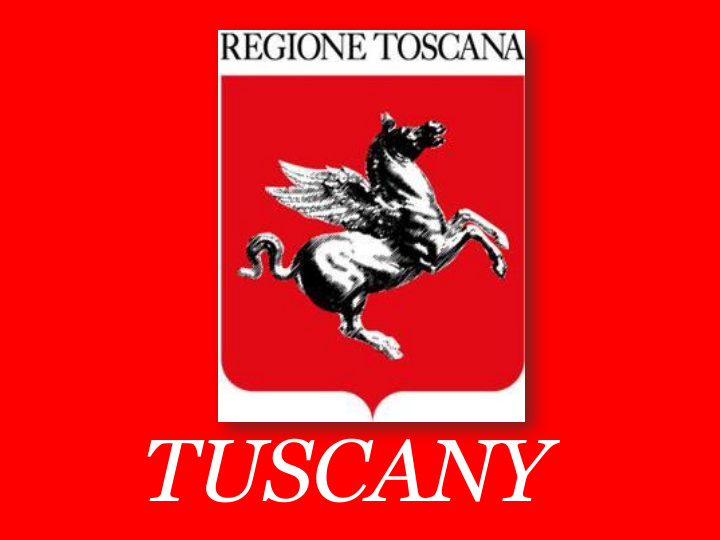



TUSCANY
FACTFILE Country: Italy Region: Tuscany Capital City: Florence Area: 22, 993 sq. km Population: 3, 753, 000 Density: 163.1 /sq.km Demonym: Tuscan
Tuscany: about 3,800 million inhabitants Italy : 60,656,000 million inhabitants Rate of natural increase: 0.5 Median Age :46.2 Life Expectancy : 11.3 Fertility Rate (births per woman) :7.2
In the late Middle Ages and Renaissance, Tuscany was the centre of the arts and learning. The Tuscan spoken language became the literary language of Italy after Petrarch and Dante used it in their works. Notable schools of architecture, sculpture and painting developed in many cities starting from the 11th century.
INTRODUCTION Tuscany, the cradle of modern European culture, contains treasures of every age and style. The cities of Tuscany have produced writers, scientists, musicians, and artists such as Michelangelo and Brunelleschi , whose works have changed the world.
GEOGRAPHICAL POSITION Tuscany is the fifth largest region in Italy. It stretches over the western side of the Apennines and includes the islands of the Tuscan archipelago .
It lies on the sea to the west and south-west and borders with Liguria to the north-west, Emilia Romagna to the north, the Marches and Umbria to the east, and Latium to the south-east. It is bounded by the Apennines to the north and east and by the Mediterranean Sea to the west.
Florence is the capital of the region, which is divided into the provinces of Pisa, Siena, Lucca, Arezzo, Pistoia, Grosseto, Leghorn and Massa-Carrara. Its main river is the Arno, on which Florence and Pisa are located.
Tuscany has mineral deposits. There are seams of cinnabar, iron, lead and lignite. The main natural parks are the Natural Park of Maremma and the Natural Park of San Rossore near Pisa.
NATURAL ENVIRONMENT Tuscany has a varied and complex morphology. The Apennines are in the north and in the east while the Apuane Alps are in the north-west.
ECONOMY The main agricultural products are cereals, wheat and wine. Olive cultivation is also excellent. Vegetable production is also worthy of note.
Industry includes the metallurgical, chemical, food, printing and tanning. In the services, banking, commerce and tourism are important.
MAIN TUSCAN INDUSTRIES The three main industries in Tuscany are Gucci , which produces leather goods and accessories as shoes, belts and suitcases, watches, jewerly, ties and clothes in Florence, Sammontana , which produces ice cream in Empoli (Florence), and Piaggio , which produces Vespa Piaggio in Pontedera (Pisa). There are a lot of world- famous tanneries and leather factories in our area.
TOURISM Tuscany is one of the regions in Italy that attracts the highest number of tourists. The most important cities are Florence, Pisa, Siena, Leghorn and Lucca.
In Tuscany there are a lot of seaside resorts, such as Forte dei Marmi, Marina di Pietrasanta, Lido di Camaiore and Viareggio in Versilia. The region is dotted with charming and often old villages. In the east there is the Pistoia mountain with its winter resorts, such as Abetone and Cutigliano.
PISA
LEGHORN
LUCCA
SIENA
GROSSETO
VERSILIA
POPULATION Tuscany counts more than three and a half million inhabitants accounting for about 6% of the Italian population, with a density of about 163/sq.km inhabitants that is lower than the national average. Slightly more than 10% of the population resides in the regional capital of Tuscany and about a third of the regional total in the metropolitan area Florence-Prato-Pistoia.
From the 1970s onwards, Tuscany has seen a continuing decline in birth rates. However, the total regional population remained relatively stable until the late 1990s, when it started to experience an increase. Among foreign residents, the citizens of Eastern European countries prevail, the percentage of Asians and Americans is lower.
POPULATION IN TUSCANY (year 2016)
CLIMATE The climate of Tuscany presents different characteristics from zone to zone, being influenced both by the sea that bathes the region to the west, and by the Apennine ridge that delimits the territory first to the north and then to the east.
The currents of air that characterize the climate of Tuscany often present different trends to the north and south of the Island of Elba, which with its Monte Capanne tends to behave like a sort of "watershed" at the meteorological level.
THE SCHOOL SYSTEM There are a lot of primary and junior secondary schools in our area. As far as secondary schools are concerned, there is a technical secondary school and a lyceum in San Miniato in the province of Pisa.
Students who are from 6 to 10 attend Primary School. Students who are from 11 to 13 attend Junior High School and students who are from 14 to 18 attend Senior High School. Education is compulsory from the age of 6 to the age of 16.
UNIVERSITY The nearest universities are located in Pisa, Florence and Siena.It takes about 45 minutes to reach the University of Pisa and Florence by train. It takes about one hour to reach the University of Siena . Most students who want to study languages and cultural mediation go to the University of Siena.
Transport
Rachele Barzacchini Alice Martini CLASSE 2FE Melissa Nannetti A.S. 2017/2018 Rose Villalobos Virginia Russo Ludovico Tamburini
Recommend
More recommend